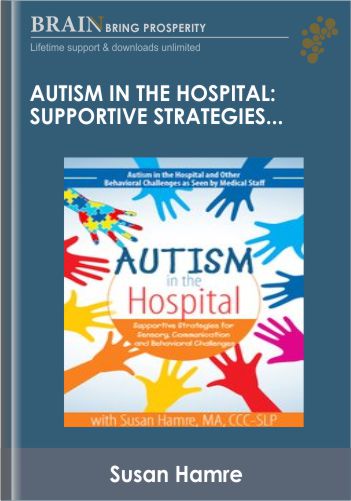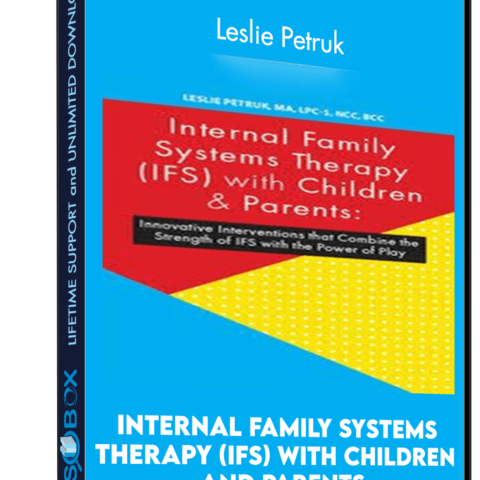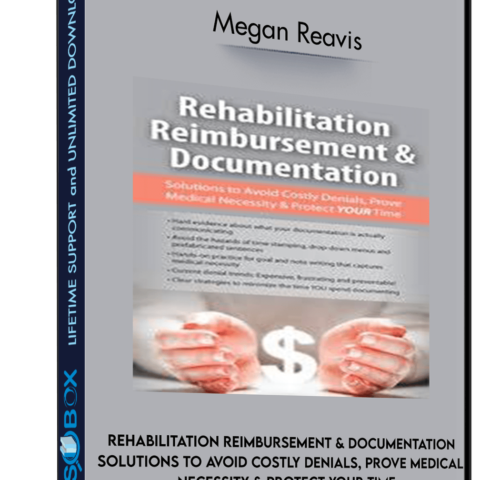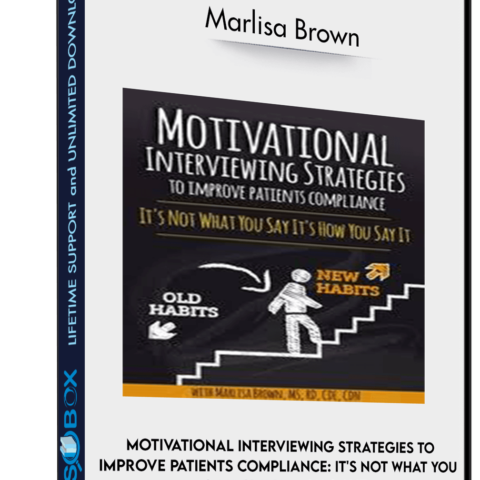Autism in the Hospital: Supportive Strategies for Sensory, Communication and Behavioral Challenges – Susan Hamre
$77.00
Whether the medical appointment is scheduled or it’s a trip to the emergency room the hospital can be a sensory minefield for someone with autism causing them… Autism in the Hospital: Supportive Strategies for Sensory, Communication and Behavioral Challenges – Susan Hamre
Description
Purchase Autism in the Hospital: Supportive Strategies for Sensory, Communication and Behavioral Challenges – Susan Hamre Course at eBokly. We actively participate in group buys and are committed to sharing knowledge with a wider audience. What's more, our courses maintain the same quality as the original sale page. You have the option to buy directly from the sale page at the full price (sale page link is provided within the post).
When purchasing Autism in the Hospital: Supportive Strategies for Sensory, Communication and Behavioral Challenges – Susan Hamre course, You can get it with the LIFETIME SUPPORT and UNLIMITED DOWNLOAD.
What will you get:
- 2018_03_27autismrnv053870_360pAAC_640x360_700.mp4
- manual.pdf
- Sensory, communication and behavioral challenges that impact successful medical treatment
- Strategies for ER triage, routine hospital visits, surgery and more
- Roadmap for treating a non-verbal, non-responsive individual with autism
- ‘Stimming’ behaviors as a strategy
- Subtle sign of less obvious ASD
Do you know how to give medical attention to a patient with autism who:
- Can’t answer your questions or identify levels of pain?
- Refuses to have blood drawn, give urine a sample, do dialysis or CT/MRI scan?
- Attempts to pull out lines or pull off bandages?
- Fights you off with piercing screaming and flapping of the arms?
- Can’t tolerate your touch and or make eye contact with you?
- Won’t stop running out of the treatment room?
- Refuses medication?
- Sensory, communication and behavioral challenges that impact successful medical treatment
- Strategies for ER triage, routine hospital visits, surgery and more
- Roadmap for treating a non-verbal, non-responsive individual with autism
- ‘Stimming’ behaviors as a strategy
- Subtle sign of less obvious ASD
Do you know how to give medical attention to a patient with autism who:
- Can’t answer your questions or identify levels of pain?
- Refuses to have blood drawn, give urine a sample, do dialysis or CT/MRI scan?
- Attempts to pull out lines or pull off bandages?
- Fights you off with piercing screaming and flapping of the arms?
- Can’t tolerate your touch and or make eye contact with you?
- Won’t stop running out of the treatment room?
- Refuses medication?
Whether the medical appointment is scheduled or it’s a trip to the emergency room the hospital can be a sensory minefield for someone with autism causing them to spiral toward a terrifying meltdown. Sedation and four-point restraint are not practical solutions.
Your connection to your autism patient will depend upon how quickly you can move into their world. Through case examples, videos and lively class discussion you will walk away with practical strategies for successful medical treatment of an individual with autism, such as:
- Hospital/EMT equipment to help support sensory needs
- Overcoming the most common sensory triggers
- Communication cards, checklists and Apps as visual supports
- Social stories to break down hospital/EMT procedures
- Navigate ER triage, routine hospital visits, labs and tests
- What to do when a meltdown occurs
- Calming techniques
- Utilize strategies to de-stimulate the ‘sensory minefield’ in your medical setting.
- Determine specific calming techniques that meets the need of your patient and increase the success of the medical experience.
- Identify critical questions to ask caregivers which can enhance the success of your treatment.
- Develop your ability to recognize a patient with undeclared and/or less obvious ASD.
- Characterize aspects of ASD that can interfere with a successful medical experience.
- Implement communication cards, social stories and visual supports to communicate with individuals who are non-verbal/under responsive.
Autism in Medical Settings: Challenges and Supportive Strategies
- Sensory Integration Challenges
- Stimulation dysregulation (hypo/hyper)
- Seeking/avoiding/both
- Processing functions
- May not process nor perceive pain
- Common triggers within the hospital/ER environment
- Your hospital/ER as a ‘sensory minefield’
- Sensory Strategies
- Patient passport with sensory triggers listed
- Quickly create ASD friendly environment
- Allow sensory needs to occur to prevent a meltdown
- How to avoid most common sensory triggers
- Hospital equipment to help support sensory needs
- Social / Communication Challenges
- Social interaction holds the ‘key’… or not
- Literal translation of spoken language
- When they are non-verbal or unable to read body language
- Delayed auditory processing
- Impact of anxiety on communication
- Non-compliance and verbally offensive
- Social/Communication Strategies
- Communication cards, checklists and Apps as visual supports
- Social stories to break down hospital procedures
- Their interests or repetitive behaviors to generate your ‘connection’
- Make allowances for family to be nearby
- Behavior Challenges
- Noting functions of behavior
- May bolt/escape/elope
- Aggression occurs as anxiety increases
- Might resist restraint
- Anxiety may increase when transport is needed intolerant of transitions in general
- Likely to be resisting lack of known/familiar routine
- Attempt to pull out lines, pull off bandages, etc.
- Refuse medication
- Behavioral Management Strategies
- Is it a meltdown or tantrum?
- Know the child’s triggers
- Plan ahead to avoid triggers
- Specific calming techniques
- What to do when a meltdown occurs
- Navigating ER triage, routine hospital visits, labs and tests
- Visual schedules for what is going to be happening
- Strategies for loud noises and being touched
- Visual timetables and timers for transitions/ changes
- Motivation and reward systems that work
- What you need to know about non-sensory triggers
- ‘Stimming’ as a calming technique
Are you interested in? Autism in the Hospital: Supportive Strategies for Sensory, Communication and Behavioral Challenges – Susan Hamre download, supportive strategies, supportive strategies for classroom management, supportive strategies consulting, supporting strategies, dementia support strategies
Purchasing Autism in the Hospital: Supportive Strategies for Sensory, Communication and Behavioral Challenges – Susan Hamre course now, You can get it with the LIFETIME SUPPORT and UNLIMITED DOWNLOAD.
Purchase the Autism in the Hospital: Supportive Strategies for Sensory, Communication and Behavioral Challenges – Susan Hamre course at the best price at eBokly. Upon completing your purchase, you will gain access to the downloads page. where you can conveniently retrieve all associated course files. Additionally, we will send you a download notification email to your registered mail.
Unlock your full potential with our Autism in the Hospital: Supportive Strategies for Sensory, Communication and Behavioral Challenges – Susan Hamre courses. Our courses are meticulously designed to empower you with the skills and knowledge needed for excellence.
Why wait? Take the first step towards greatness by acquiring our Autism in the Hospital: Supportive Strategies for Sensory, Communication and Behavioral Challenges – Susan Hamre courses today. We ensure a smooth and secure purchasing experience that guarantees your peace of mind. Rest assured that your financial information is safeguarded through our trusted payment gateways, Stripe and PayPal.
Stripe, renowned for its robust security measures, offers a secure and dependable payment process. Your sensitive data is encrypted using state-of-the-art technology, ensuring its confidentiality throughout the transaction.
PayPal, a globally recognized payment platform, adds an extra layer of security. With its buyer protection program, you can make your purchase with confidence, knowing that your financial details are protected, allowing you to focus on your learning journey.
Is it secure? to Use of?
- Rest assured, your identity remains completely confidential. We do not share your information with anyone, ensuring the utmost security when you buy the Autism in the Hospital: Supportive Strategies for Sensory, Communication and Behavioral Challenges – Susan Hamre course.
- 100% Safe Checkout Privateness coverage
- We employ robust communication and encryption methods to protect sensitive information. All card numbers are encrypted using AES at rest-256, and the transmission of card numbers occurs in a separate hosting environment, without sharing or storing any data.
How Will the Course Be Delivered?
- Upon successful payment for the “Autism in the Hospital: Supportive Strategies for Sensory, Communication and Behavioral Challenges – Susan Hamre course”, Most of the products will come to you immediately. But for some products were posted for offer. Please wait for our response, it might take a few hours due to the time zone difference.
- If this occurs, kindly be patient. Our technical department will process the link shortly, and you will receive notifications directly via email. Your patience is greatly appreciated.
What Shipping Methods Are Available?
- You will receive a download link in the invoice or in YOUR ACCOUNT.
- The course link is always accessible. Simply log in to your account to download the Autism in the Hospital: Supportive Strategies for Sensory, Communication and Behavioral Challenges – Susan Hamre course whenever you need.
- You can study online or download the content for better results, making it accessible from any device. Ensure your system does not go to sleep during the download process..
How Do I Track Order?
- We promptly update the status of your order following your payment. If, after 7 days, there is no download link provided, the system will automatically process a refund..
- We love to hear from you. Please don’t hesitate to email us with any comments, questions and suggestions.
You must be logged in to post a review.

 Purchase this course you will earn
Purchase this course you will earn 







Reviews
There are no reviews yet.